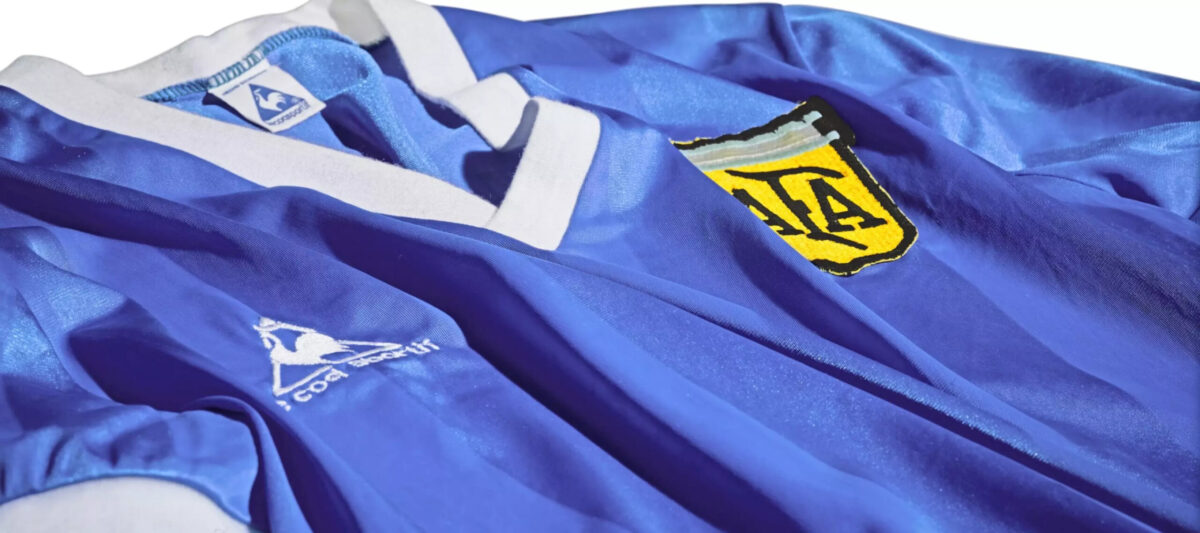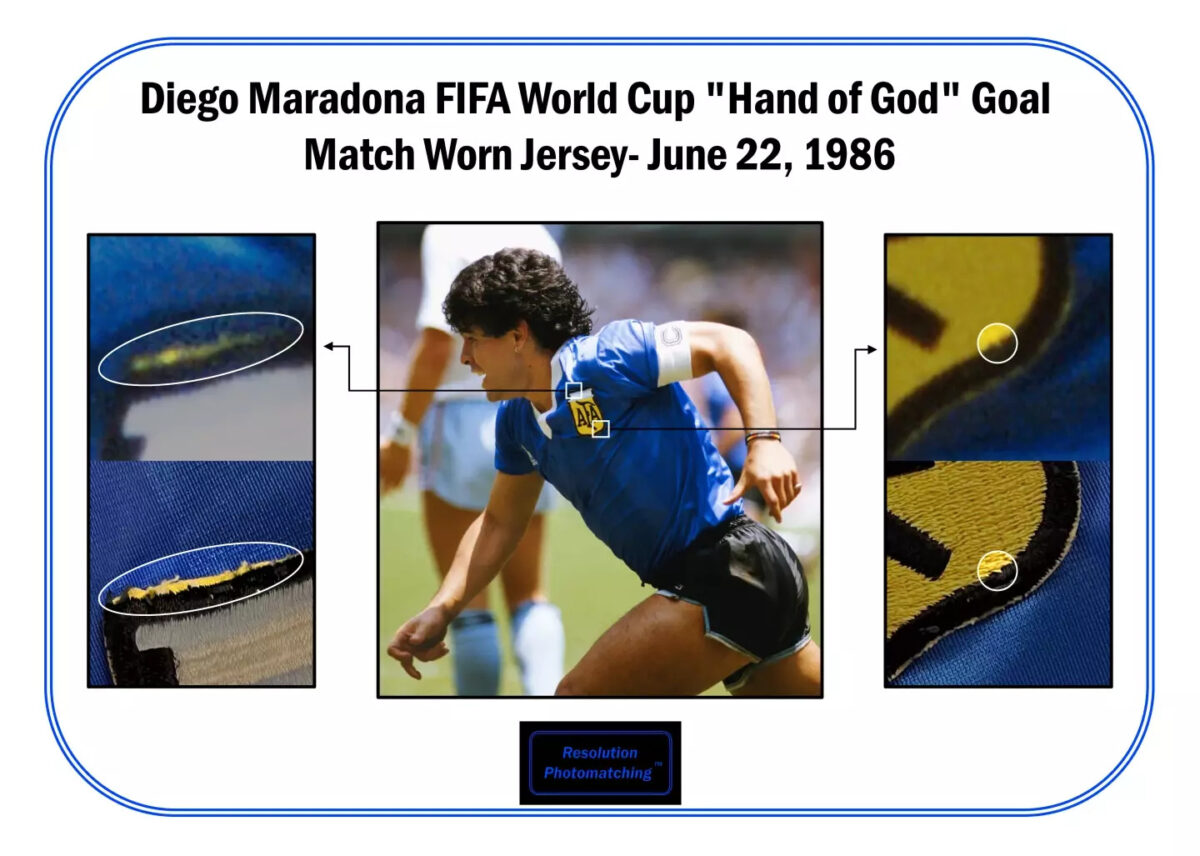It’s serendipitously fitting in so many ways that as Diego Maradona’s infamous “Hand of God” World Cup kit goes to auction, it is accompanied by claims of falsehood and unsurprising controversy while coming back full circle to England.
It was June 22, 1986 when Argentina would face England in the World Cup quarterfinals. A seasoned 25-year old Diego Maradona was now the team captain, battle tested and hungry after performing below expectations during his first World Cup four years prior. To fully appreciate the historical significance and rivalry between these two countries at that time, we must go back to the Falkland Islands War, a brief undeclared war fought between Great Britain and Argentina.
The Falkland Islands are in the South Atlantic, 300 miles east of Argentina’s coast. Although Argentina had claimed sovereignty, Britain seized these islands in 1833 and re-established their sovereignty while expelling the small number of Argentine occupants. On April 2, 1982, Argentina invaded and occupied the Falkland Islands as a result of the ongoing dispute over the territories’ sovereignty.
The British government dispatched its navy to engage the Argentine Navy and Air Force, eventually making an amphibious attack on the islands. The conflict lasted 74 days and ended with a British victory. Neither state had officially declared war, but 649 Argentine military personnel and 255 British military personnel lives were lost as a result. It was under the backdrop of this rivalry steeped in historical significance that Argentina and England faced off during the 1986 World Cup quarterfinals.
Maradona would go on to score two of his most famous goals that day. The first occurred early in the second half when he leaped in the air to strike the ball with his hand just before it could be punched away by England goalkeeper Peter Shilton. Without a clear view of the play, and Maradona celebrating immediately with his teammates in convincing fashion, the referees were fooled into allowing the illegitimate goal to stand despite the protests from England’s players.
Replays showed the hand ball, but when pressed, Maradona elusively described the goal as being, “A little with the head of Maradona and a little with the hand of God.” The goal would thereafter come to be known as the “Hand of God.”
His second goal occurred just four minutes later, with Maradona dribbling over 60 yards while taking on nearly the entire England defense and beating Shilton again to score what would be voted by FIFA as the greatest goal in the history of the World Cup. Although England’s Gary Lineker scored a goal in the 81st minute and nearly equalized in the closing seconds, Argentina won the match 2-1. Maradona would later state that their victory was revenge against England for its actions during the Falklands War.
In an ironic twist of fate, it was England midfielder Steve Hodge — whose back pass had been intercepted by Maradona on the “Hand of God” goal — who ended up in possession of the famous shirt. Hodge had originally thought to ask to swap shirts at the end of the game while shaking hands, but was unable to do so as Maradona was being mobbed by his teammates and conducting TV interviews. Later on in the tunnel he had another chance encounter, and this second time around was successfully able to exchange jerseys with the Argentinian captain.
Maradona later confirmed this exchange as well in his book, Touched by God. “On the way to the locker room, one of the English guys—it turned out to be Hodge, but I wasn’t sure at the time—asked me to swap jerseys with him. I said yes and we did.”
How the shirt even came to be has an interesting backstory of its own. According to Touched by God, the Argentina team had an eyelet mesh home jersey made by Le Coq Sportif. However, the brand famous for its rooster logo had neglected to provide them with a similar light mesh alternate jersey. The team became concerned when it found out it would have to wear its thick cotton blue jerseys against England in the scorching Mexico City heat.

With not enough time for the brand to make lightweight home jerseys, Argentina coach Carlos Bilardo sent staff member Ruben Moschella to search for a last minute replacement. Moschella went to 40 different stores before finding two adequate options one day before the game against England. When asked, Maradona pointed to one choice and said, “That one. We’ll beat England in that one.”
However, “that one” was missing the national team emblem and the numbers. Two seamstresses at their training camp sewed on AFA patches but missed some details including the laurel leaves. The numbers were then ironed onto 38 jerseys by Argentina’s kit man.
Maradona’s No. 10 shirt had been with Hodge since their post game swap, and he later loaned it out to the National Football Museum in Manchester for display. After Maradona’s death last year, Hodge said the shirt was not for sale but has now decided to put it up for auction.
“I have been the proud owner of this item for over 35 years,” Hodge said in a press release. “The Hand of God shirt has deep cultural meaning to the football world, the people of Argentina, and the people of England, and I’m certain that the new owner will have immense pride in owning the world’s most iconic football shirt.”
The famous blue Argentina jersey is currently offered at auction by Sotheby’s with an estimated value of £4-6 million ($5.02-7.5 million). Yet, an iconic Maradona kit potentially selling for a record amount wouldn’t be complete without some added controversy. After the announcement of the auction, Maradona’s family has come out stating that the shirt being offered up for sale is not the one that was worn while the two goals were scored. The family is saying that the shirt Hodge received was worn during the goalless first half.
Dalma Maradona, Diego Maradona’s eldest daughter, went on Argentina radio to claim that the shirt worn in the second half was in the hands of another owner, but declined to name the person.
“It’s not that one,” she said. “I don’t want to say who has it because it’s crazy. He (Diego Maradona) said it. He said, ‘How am I going to give him the shirt of my life?’ This former player thinks he has my dad’s second-half jersey, but it’s a mix-up. He has the one from the first half.”
Sotheby’s has firmly refuted any claim that the shirt for auction is not the second-half jersey. Melica Khansari, the deputy director of communications for Sotheby’s, acknowledges that there was a different shirt worn by Maradona between the first and second half. However, Khansari stated, “There are clear differences between that and what was worn during the goals. And so, prior to putting this shirt for sale, we did extensive diligence and scientific research on the item to make sure it was the shirt worn by Maradona in the second half for the two goals.”

In efforts to further prove authenticity, Sotheby’s hired an outside firm, Resolution Photomatching, to analyze the shirt against photos taken during the 1986 match. According to Khansari, “Resolution Photomatching did determine that Maradona switched shirts during the match, but that Maradona did wear this shirt for both historic goals in the second half of the match.”
Someone will soon become the new, proud owner of a significant piece of football history that embodies the historic rivalry and deeply personal nature between these two countries. It’s not surprising that Diego Maradona has shown us once again, even in his legacy, the ability to take something ordinary and sprinkle some controversy and audacity and convert it into something magical. Perhaps now, England can at long last be at peace with the occurrences from 40 years ago through this symbolic gesture and finally close the circle.








